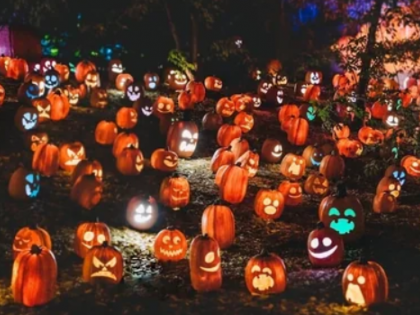Halloween 2025: Date, History, Meaning, and Why the World Celebrates the Spookiest Night of the Year
By Lokmat Times Desk | Updated: October 30, 2025 16:19 IST2025-10-30T16:19:11+5:302025-10-30T16:19:11+5:30
As October fades into its final days, the air begins to buzz with excitement and a hint of eeriness. ...

Halloween 2025: Date, History, Meaning, and Why the World Celebrates the Spookiest Night of the Year
As October fades into its final days, the air begins to buzz with excitement and a hint of eeriness. Streets fill with carved pumpkins, cobwebbed corners, and children plotting their spooky disguises — all signaling the arrival of Halloween. It’s that special time of year when the strange becomes delightful and the night transforms into a celebration of mystery and magic. Blending folklore, fright, and fun, Halloween continues to enchant people across the world, uniting them in the thrill of storytelling, costumes, and creative celebration.
Halloween 2025: When is Halloween?
Halloween, one of the most eagerly awaited festivals of the year, is observed annually on October 31. In 2025, it lands on a Friday, offering a perfect opportunity for a weekend of costume parties, trick-or-treating, and spine-chilling fun. Traditionally, the date is connected to All Saints’ Day, a Christian observance that followed ancient Celtic harvest rituals. Once believed to be the night when spirits could visit the living, Halloween has now become a time for glowing pumpkins, haunted houses, and playful scares, blending centuries-old customs with modern-day revelry.
Also Read: Punjab Crime: Three Armed Men Rob Jalandhar Jewellery Store, Incident Caught on CCTV (Watch Video)
Halloween 2025: Why is it Celebrated?
The story of Halloween begins with the ancient Celtic festival of Samhain, marking the end of harvest and the beginning of winter across regions of Ireland, the UK, and northern France. The Celts believed that during Samhain, the line between the living and the dead blurred, allowing spirits to wander freely. Bonfires were lit and masks were worn to drive away or disguise from these ghosts. As Christianity spread, November 1 was declared All Saints’ Day, turning the evening before into All Hallows’ Eve — later known as Halloween. Over time, it evolved into a joyous, secular event full of creativity and community spirit.
From Ancient Roots to Modern Revelry
Once steeped in rituals of remembrance and protection, Halloween today thrives as a celebration of imagination and fun. It’s a night that fuses the eerie with the entertaining, where folklore inspires creativity through costumes, décor, and festivities. Modern Halloween embraces the playful side of fear — from haunted houses and ghost stories to trick-or-treating and themed parties. Though its origins are ancient, the festival’s enduring appeal lies in its ability to bring people together through shared laughter, creativity, and the timeless charm of the mysterious.
Open in app